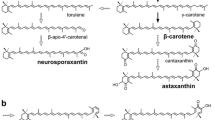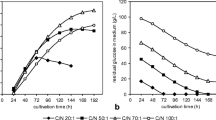Summary
Anaerobic conditions completely block the synthesis of carotenoids in Fusarium aquaeduciuum or Neurospora crassa. Even after sufficient illumination of the mycelia in the presence of air, the subsequent production of carotenoids in the dark is suppressed entirely when the fungi are transferred to an oxygen-free atmosphere. In turn, restoring aerobic conditions sets off the pigment synthesis in the dark without renewed photoinduction at any time within 48 hours, although the yields of carotenoids decrease. Thus the “photo-induced state” appears to be fairly stable. In order to locate this state the sequence of light-induced reactions was specifically blocked before and after the synthesis of carotenogenic enzymes.
Cycloheximide is a potent inhibitor of protein synthesis in fungi. When applied prior to illumination to either of the two molds it suppresses the photo-induced carotenoid formation, apparently by blocking the production of carotenogenic enzymes. This inhibition can be overcome by removing cycloheximide (e.g. by rinsing the mycelium with buffer) at any time (up to 30 h) during the dark period following illumination; however, gradually declining quantities of pigment are produced. These results provide evidence for the formation of a remarkably lasting “induction product” which can clearly be distinguished from the “photooxidative product” and from the carotenogenic enzymes.
Under anaerobic conditions Fusarium is capable of producing plentiful amounts of carotenogenic enzymes, while Neurospora crassa forms only small quantities. In order to test the stability of these enzymes in vivo the following experimental setting was employed: in the presence of air the fungi were illuminated and subsequently kept in the dark for a period as long as the absolute lag phase of the pigment synthesis. Then cycloheximide was added to block any further protein synthesis, and at the same time the mycelia were transferred to a nitrogen atmosphere. Returning the fungi to aerobic conditions after various incubation periods resulted in a successively reduced pigment production. It thus appears that the activity of the photo-induced carotenogenic enzymes diminishes only slowly in vivo. These enzymes somehow seem to be stabilized as long as carotenogenesis is blocked.
Similar content being viewed by others
Literatur
Batra, P. P.: Mechanism of photoinduced carotenoid synthesis. Induction of carotenoid synthesis by antimycin A in the absence of light in Mycobacterium marinum. J. biol. Chem. 242, 5630–5635 (1967).
Bindl, E., Lang, W., Rau, W.: Untersuchungen über die lichtabhängige Carotinoidsynthese. VI. Zeitlicher Verlauf der Synthese der einzelnen Carotinoide bei Fusarium aquaeductuum unter verschiedenen Induktionsbedingungen. Planta (Berl.) 94, 156–174 (1970).
Harding, T. W., Mitchell, H. K.: The effect of cycloheximide on carotenoid biosynthesis in Neurospora crassa. Arch. Biochem. 128, 814–818 (1968).
Rau, W.: Über den Einfluß der Temperatur auf die lichtabhängige Carotinoidsynthese von Fusarium aquaeductuum. Planta (Berl.) 59, 123–137 (1962).
—: Untersuchungen über die lichtabhängige Carotinoidsynthese. I. Das Wirkungs-spektrum von Fusarium aquaeductuum. Planta (Berl.) 72, 14–28 (1967a).
—: Untersuchungen über die lichtabhängige Carotinoidsynthese. II. Ersatz der Lichtinduktion durch Mercuribenzoat. Planta (Berl.) 74, 263–277 (1967b).
—: Untersuchungen über die lichtabhängige Carotinoidsynthese. IV. Die Rolle des Sauerstoffs bei der Lichtinduktion. Planta (Berl.) 84, 30–42 (1969).
—, Lindemann, I., Rau-Hund, A.: Untersuchungen über die lichtabhängige Carotinoidsynthese. III. Die Farbstoffbildung von Neurospora crassa in Submerskultur. Planta (Berl.) 80, 309–316 (1968).
Rilling, H. C.: Photoinduction of carotenoid synthesis of Mycobacterium sp. Biochim. biophys. Acta (Amst.) 60, 548–556 (1962).
—: On the mechanism of photoinduction of carotenoid synthesis. Biochim. biophys. Acta (Amst.) 79, 464–475 (1964).
Theimer, R. R., Rau, W.: Untersuchungen über die lichtabhängige Carotinoidsynthese. V. Aufhebung der Lichtinduktion durch Reduktionsmittel und Ersatz des Lichts durch Wasserstoffperoxid. Planta (Berl.) 92, 129–137 (1970).
Zalokar, M.: Studies on biosynthesis of carotenoids in Neurospora crassa. Arch. Biochem. 50, 71–80 (1954).
—: Biosynthesis of carotenoids in Neurospora. Action spectrum of photoactivation. Arch. Biochem. 56, 318–325 (1955).
Author information
Authors and Affiliations
Rights and permissions
About this article
Cite this article
Rau, W. Untersuchungen über die lichtabhängige Carotinoidsynthese. Planta 101, 251–264 (1971). https://doi.org/10.1007/BF00386832
Received:
Issue Date:
DOI: https://doi.org/10.1007/BF00386832




